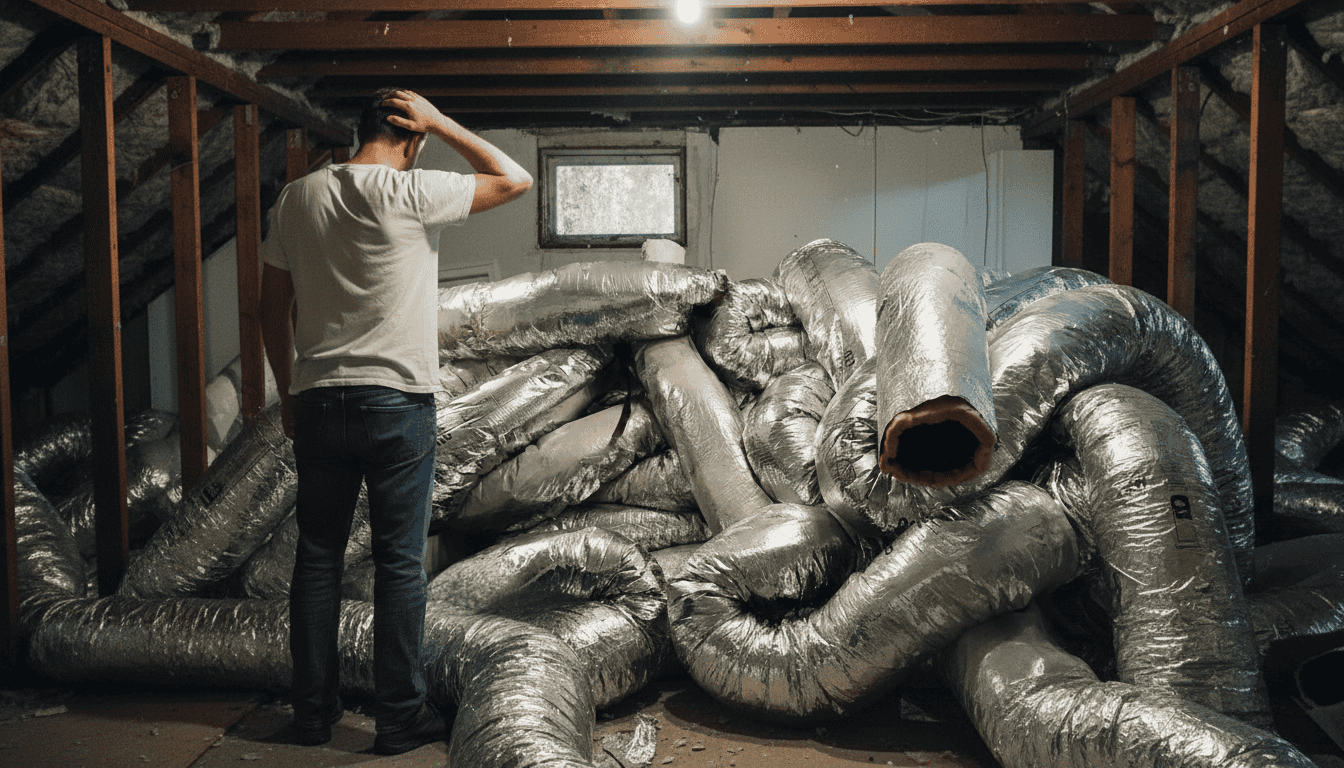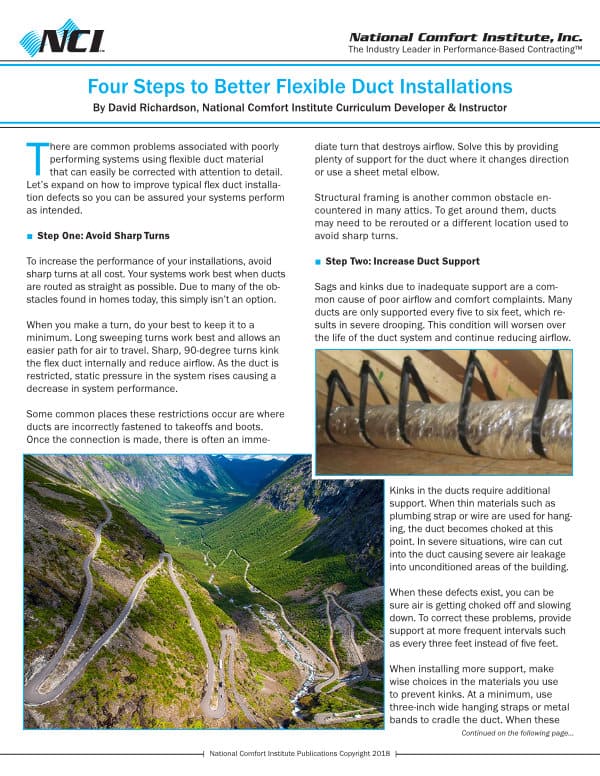Your existing rigid metal ductwork is a hidden goldmine; don’t let anyone convince you to replace it with cheap, inferior flexible alternatives.
The Great Ductwork Downgrade: Why Contractors Push Flex
Here’s what’s happening in homes across New Orleans: HVAC contractors are systematically replacing superior rigid metal ductwork with cheap flexible alternatives, and homeowners are paying the price for decades.
Why? Because flex ductwork is faster, cheaper, and easier to install. It springs out of the box like a jack-in-the-box, requires no prefabrication, and can be tossed around corners without a second thought. For contractors, it’s a dream. For your home’s performance, it’s a nightmare.
The Shocking Truth About Flex Ductwork Performance
Texas A&M University conducted groundbreaking research that should terrify anyone considering flexible ductwork. Their findings are absolutely damning:
Even at just 4% compression, flex ducts move 37% less air than rigid metal
At 15% compression, friction rates double
At 30% compression, friction rates quadruple
Studies show pressure losses up to 10 times greater than steel duct
Here’s the kicker: Flex ductwork is “almost never installed correctly”. Even skilled installers struggle with proper installation because the slightest compression, kink, or sag destroys performance. Meanwhile, your rigid metal ductwork delivers consistent, efficient airflow for decades.
What This Performance Disaster Costs You
Every month your home runs on poorly performing flex ductwork, you’re hemorrhaging money:
10-40% reduced system efficiency from poor ductwork alone
Higher energy bills from systems working overtime to compensate
Premature HVAC equipment failure from excessive strain
Uneven temperatures throughout your home
Reduced comfort and inferior air quality
Research shows that homes with properly designed ductwork can save 20-30% on energy bills. When you replace superior, rigid metal with inferior flex, you’re voluntarily choosing higher bills and reduced comfort.
Your Rigid Metal Ductwork: Built to Last Generations
Your existing metal ductwork represents decades of superior engineering. Here’s what you’re protecting:
Unmatched Durability: Metal ductwork lasts 30-50 years or more with proper maintenance. Compare that to flex ductwork’s 10-15 year lifespan in best-case scenarios.
Superior Airflow: The smooth interior surfaces of metal ducts minimize air resistance, allowing your HVAC system to operate at peak efficiency. This isn’t just theory, it’s measurable performance that shows up in your energy bills.
Structural Integrity: Metal ducts maintain their shape and performance over time. They don’t sag, compress, or develop the performance-killing issues that plague flexible alternatives.
The Installation Quality Difference
When rigid metal ductwork was installed in your home, it required skilled craftsmen who carefully planned every connection, sealed every joint, and routed ducts in straight, efficient lines. This attention to detail creates superior long-term performance.
Flexible ductwork installations are rushed and often careless. Because it’s “easy” to install, contractors frequently:
Create excessive bends and compressions
Use improper support systems
Allow sagging that destroys airflow
Skip proper sealing procedures
The result? A system that underperforms from day one and gets worse over time.
Don’t Fall for the “Modernization” Scam
When contractors suggest replacing your rigid metal ductwork, they’re not upgrading your system, they’re downgrading it. This isn’t modernization; it’s systematic degradation of your home’s performance.
Your metal ductwork was the gold standard when it was installed, and it remains the superior choice today. The shift to flexible ductwork wasn’t driven by performance improvement. It was motivated by cost-reduction and installation convenience for contractors.
Energy Efficiency That Pays You Back
Rigid metal ductwork delivers superior energy efficiency that translates directly to lower utility bills. The smooth interior surfaces create minimal air resistance, allowing your HVAC system to move air efficiently throughout your home.
Independent research proves steel duct airflow energy efficiency is far superior to polyester flex products. This means your existing metal ductwork is already providing optimal performance. Don’t sacrifice it for an inferior alternative.
The Cleaning and Maintenance Advantage
Metal ducts are easier to clean and maintain than flexible alternatives. Their smooth surfaces resist dust accumulation, and they can withstand professional cleaning without damage. Many indoor air quality professionals state that flexible ducts cannot be effectively cleaned and must be replaced when contaminated.
This cleaning advantage means better long-term air quality and reduced maintenance costs – another way your existing metal ductwork continues saving you money.
Protect Your Investment. Fight Back!
Your rigid metal ductwork is a valuable asset. Don’t let contractors convince you otherwise. When they suggest replacement with flex alternatives, you’re being asked to trade a Mercedes for a go-kart.
Unless your entire duct system needs a complete redesign, the smart financial move is to preserve your superior metal ductwork and upgrade the insulation around it. This approach maintains all the performance advantages while addressing any efficiency concerns.
The Bottom Line: Superior Systems Don’t Need Replacement
Replacing rigid metal ductwork with flexible alternatives is like replacing a solid foundation with quicksand. Your metal ducts provide:
Consistent, efficient airflow for decades
Lower energy costs through superior performance
Easier maintenance and cleaning
Structural integrity that doesn’t degrade
Investment protection that pays dividends
When HVAC contractors push flex ductwork replacement, remember: You’re not getting an upgrade, you’re getting a downgrade that will cost you money, comfort, and performance for years to come.
There are cases when the existing rigid metal ductwork needs to be removed, such as a full system overhaul, logistical duct changes, additions, sizing, etc. Before blindly assuming your existing duct system requires being sold for scrap, first ask if and why its necessary to downgrade. Your metal ducts are gold—treat them that way.
Frequently Asked Questions
The difference is dramatic, and backed by independent university research. Rigid metal ductwork significantly outperforms flexible alternatives due to fundamental building science principles around air friction, static pressure, and system efficiency.
The Physics Behind the Difference
Flexible ductwork has a helical wire core that creates an uneven, ridged interior surface (imagine a spiral staircase for air molecules). Metal ducts have smooth interior surfaces that allow air to flow efficiently without excessive turbulence or friction.
Research from the Florida Solar Energy Center (FSEC) at the University of Central Florida conducted a comprehensive 2-year experimental study comparing metal and flex duct systems under identical conditions. Their findings are definitive:
Test Results from FSEC Research:
Best-case flex installation (Test 1): 5% more cooling energy than metal
Typical flex installation (Test 3): 9-14% more cooling energy than metal
Poorly installed flex (Test 2): 14% more cooling energy than metal
Predicted annual energy penalty in Miami climate: 422 kWh/year (9% increase) for a typical flex system
What Drives the Energy Penalty:
The FSEC research discovered that most of the energy difference came from increased air handler fan motor energy. When static pressure rises (as it does with flex ducts), the fan motor must work harder to push air through the system. Test 3 flex ducts required 72% more daily fan motor energy than metal ducts, even though total cooling energy increased only 9%.
This is where building science gets interesting: Air flow restriction in flexible ductwork creates higher Total External Static Pressure (TESP):
Well-designed metal duct system: 0.34 inches of water column (in WC)
Best-practice flex installation: 0.44 in WC
Typical flex installation: 0.82 in WC (2.4x higher!)
Poorly installed flex: 1.0 in WC (3x higher!)
This static pressure difference means your HVAC system works significantly harder to move air through flexible ductwork, consuming more energy and generating more heat, which affects cooling efficiency.
National Comfort Institute Research:
The National Comfort Institute documented four critical flex duct installation defects that destroy performance:
Sharp turns and kinks – Reduce airflow by creating an internal obstruction
Inadequate support – Ducts sag under their own weight, crushing the core
Excess core bunching – Compressed inner membrane reduces effective duct diameter
Improper sizing – Flex ducts are almost always undersized compared to equivalent metal duct systems
The National Comfort Institute concluded that “flex ducts are almost never installed correctly,” even by experienced contractors, because achieving proper installation requires continuous attention to spacing, support intervals, and routing geometry.
Compression destroys flex duct performance, and it’s almost invisible to the naked eye. This is one of the most critical building science problems with flexible ductwork.
The Compression Penalty:
Research documented in ACCA Manual D specifications shows:
4% compression: Friction rate increases, airflow reduced
15% compression: Friction rates DOUBLE compared to uncompressed flex duct
30% compression: Friction rates QUADRUPLE
What This Means in Real Homes:
In the FSEC study, when the flex duct test configuration was modified to include realistic compression (Test 3 with +30% extra duct length and partial register closure), the system static pressure jumped from 0.44 in WC to 0.82 in WC—a 87% increase! This additional compression created that 9% annual energy penalty measurable in real dollars.
Why Compression Happens:
Even “properly installed” flex ductwork experiences compression from:
The weight of the insulation pressing down on the inner core
Inadequate support every 5-6 feet (should be every 3 feet minimum per ACCA standards)
Wire strapping or improper hanging materials that crimp the duct
Routing around obstacles, forcing bends tighter than the duct diameter
Time and sagging – ducts sag over the years, worsening compression
The Building Science Reality:
The inner core of flex ductwork is designed to maintain a circular cross-section. When compressed, the core collapses into an oval or kidney-shaped profile, dramatically increasing surface area contact with air. More contact = more friction. More friction = reduced airflow and increased static pressure.
Metal ducts, by contrast, maintain their structural integrity indefinitely. Mild steel or aluminum ducts cannot be compressed into oval shapes—they remain round and maintain consistent performance for 30-50 years.
The FSEC study from the University of Central Florida is the most comprehensive direct energy comparison ever conducted. Here’s what it definitively proves:
Study Methodology
The FSEC created two identical test houses side-by-side with identical HVAC systems. Over nearly 2 years, they measured cooling energy consumption under identical weather conditions—the only variable was the ductwork type.
Key Finding: Air Handler Fan Energy is the Culprit
The study discovered that the entire energy penalty comes from increased fan motor work, not from duct insulation differences. Even though both systems had R-6 insulation, the flex system consumed more energy because:
Higher static pressure requires more fan energy – As TESP increased in the flex system (from 0.34 to 0.82 in WC), the ECM fan motor increased speed to maintain the designed airflow, consuming substantially more energy
Fan energy directly becomes sensible heat – This increased motor energy generates heat that adds to the cooling load, requiring the compressor to work harder
Compounding effect – Fan working harder + compressor working harder = more total energy consumption
The Annual Energy Impact (Florida Climate Zones 1A & 2A):
Test 3 (typical flex installation) used approximately 422 kWh/year more than metal ducts, representing:
$51/year in increased energy costs (at $0.12/kWh)
9% higher annual cooling energy consumption
$510-2,040 over a 10-20 year equipment lifespan
Miami-specific data showed even higher impact: Because Miami has hotter temperatures year-round (Climate Zone 1A), the flex duct penalty was 229 kWh/year greater than Orlando (Climate Zone 2A), demonstrating that hotter climates experience greater energy penalties with flex ductwork.
Peak Power Impact:
The FSEC study also measured peak cooling power demand. Flex Test 3 showed a 9% increase in peak power (0.233 kW additional draw) compared to metal. This is significant because:
Peak demand drives electrical grid strain
Utilities must build generating capacity to meet peak demand
Higher peak power increases demand charges on commercial and some residential accounts
From a grid reliability perspective, metal ducts reduce peak power stress
Static pressure is the fundamental building science principle that explains why metal ducts outperform flex. Understanding this helps you understand why your metal ductwork is worth preserving.
What is Static Pressure?
Static pressure is the resistance to airflow in the duct system. When your HVAC blower turns on, it must overcome this resistance to push air through ducts, bends, fittings, registers, and filter. Higher static pressure = more blower work required.
How Metal vs. Flex Creates Different Static Pressures:
The Building Physics:
TESP (Total External Static Pressure) is the sum of all resistance in the system. When TESP is low (metal ducts), the fan motor can deliver designed airflow at lower speeds. When TESP is high (flex ducts), the fan must run faster, consuming exponentially more energy.
The relationship isn’t linear—doubling the static pressure doesn’t double the fan energy. Fan energy increases with the cube of the speed change (according to the fan laws in thermodynamics). This means small increases in static pressure create disproportionately large increases in fan motor energy consumption.
Real-World Numbers from FSEC:
Metal duct TESP: 0.34 in WC
Flex duct TESP: 0.82 in WC (2.4x higher)
Fan motor energy increase: 72% (not 2.4x, but much more than proportional)
This is where metal ductwork demonstrates true long-term value and why preserving existing metal ducts makes financial sense.
Service Life Comparison:
Why Metal Lasts Longer:
Metal ducts are passive – they don’t degrade chemically or physically. Properly sealed metal ductwork can function identically for 50 years. The only maintenance required is occasional duct cleaning.
Flexible ducts actively degrade:
Insulation binder breaks down with age and moisture exposure
The inner plastic membrane can crack or develop holes
Wire reinforcement can rust in humid environments
Compression and sagging worsen over time due to gravity and heating cycles
Seals and connections fail as materials age
The Financial Reality:
If your existing metal ductwork is 20 years old, it likely has another 20-30 years of service life remaining. Replacing it with flex ductwork means:
Immediate $5,000-15,000 replacement cost
9% higher energy bills starting immediately
Replacement needed again in 10-15 years (another $5,000-15,000 cost)
No performance improvement, only degradation
This is one of the worst return-on-investment HVAC decisions a homeowner can make from both a financial and environmental perspective.
This is fundamental building science—surface roughness directly impacts air friction and system performance.
Material Surface Properties
Metal Ducts – Smooth Interior:
Surface friction factor: 0.004-0.008 (extremely low)
Air velocity: Consistent across duct cross-section
Turbulence: Minimal
Friction loss: Baseline (lowest)
Flexible Ducts – Ridged Helical Interior:
Surface friction factor: 0.010-0.015+ (2-3x higher)
Air velocity: Uneven due to helical obstruction
Turbulence: Significant near helical core
Friction loss: High baseline, worsens with compression
Why This Matters – The Moody Friction Factor
Duct engineers use the Moody Friction Factor to calculate pressure drop. This scientific relationship shows that surface roughness directly increases friction loss.
For a 6-inch duct running 100 feet with 500 CFM airflow:
Metal duct: Approximately 0.05-0.08 in WC pressure drop
Flexible duct (uncompressed): Approximately 0.12-0.18 in WC pressure drop
Flexible duct (compressed): Approximately 0.25-0.40+ in WC pressure drop
Multiply these pressure drops across a typical 15-20 duct branches in a home, and the cumulative effect is significant system-wide static pressure increase.
Turbulence and Energy Loss
The helical wire inside flex ductwork creates a turbulent boundary layer around the air stream. This turbulence:
Increases friction significantly
Generates noise (why flex ducts often sound like wind whistling)
Reduces the effective duct diameter
Increases temperature differential as turbulent mixing generates more frictional heat
Metal ducts, with their smooth surfaces, maintain a laminar airflow pattern that minimizes energy dissipation.
Metal ducts have a significant maintenance advantage that affects long-term performance and air quality.
Cleaning and Maintenance Comparison
Why Metal Ducts Clean Better
The smooth, rigid interior of metal ducts allows professional cleaning equipment to:
Access the entire interior surface without obstruction
Dislodge debris effectively using brushes and air
Dry completely after wet cleaning (important in humid climates like Louisiana)
Survive repeated cleaning without damage
Flexible Duct Cleaning Problems
The helical wire core creates internal obstructions that:
Trap dust and debris that cleaning equipment can’t reach
Prevent proper drying after wet cleaning (moisture gets trapped inside helix)
Risk of puncture damage from aggressive cleaning tools
Often requires replacement rather than successful cleaning
Air Quality Implications
This maintenance difference is significant in humid climates like Louisiana where moisture and mold growth are concerns:
Metal ducts: Can be cleaned, dried, and maintained indefinitely
Flexible ducts: Once contaminated with moisture-trapped mold, often cannot be effectively remediated
If air quality issues develop, metal ducts can be professionally cleaned. Flexible ducts often require expensive replacement.
From a building science and environmental perspective, preserving existing metal ductwork is the sustainable choice.
Manufacturing Environmental Impact:
Creating new ductwork, whether metal or flex, requires:
Raw material extraction and processing
Energy-intensive manufacturing
Transportation and installation
Disposal of old ductwork as waste
According to lifecycle analysis principles, the most sustainable ductwork is the ductwork that’s already installed and performing well.
Operational Environmental Impact:
Over a 20-year period:
Metal ductwork: Adds approximately 0% to home energy consumption vs. baseline (stable over time)
Flexible ductwork: Adds approximately 180 kWh/year × 20 years = 3,600 kWh of additional energy consumption
At an average grid carbon intensity of 0.4 kg CO2/kWh, that represents:
1,440 kg (3,168 lbs) of additional CO2 emissions over the ductwork lifespan
Equivalent to burning 177 gallons of gasoline
By preserving your existing metal ductwork, you avoid this environmental penalty entirely.
Waste Reduction:
Keeping metal ducts: Zero replacement waste
Replacing with flex: Old ductwork becomes waste (often sent to landfill)
Replacement cycle: New flex ducts must be replaced again in 10-15 years (more waste)
Lifecycle Environmental Cost:
This analysis demonstrates that preserving metal ductwork is the environmentally responsible choice.
Honestly? Very rarely. Here are the only legitimate reasons to replace existing metal ductwork:.
Legitimate Replacement Scenarios:
Complete system redesign required – If your home undergoes major renovation (additions, layout changes) that requires entirely new duct routing, replacement may be unavoidable. Even then, keep metal ducts rather than switching to flex.
Severe structural damage – If metal ducts are severely corroded (rust penetration), physically damaged from collisions/animal damage, or have developed significant seam failures that cannot be sealed, replacement might be necessary.
Design inadequacy – If original ductwork was significantly undersized or poorly designed (wrong diameter branches, inadequate supply/return balance), and repairs aren’t feasible, new metal ducts are the solution.
NOT Legitimate Reasons (Contractor Sales Talk):
“Your ducts are old and need updating” – Age is irrelevant if performance is adequate
“Flex ductwork is more modern” – Modern doesn’t mean better
“We can save money with flex” – False; you’ll pay more in energy bills
“Flex is easier to work with” – True for contractors, not for homeowners
“Your metal ducts are inefficient” – Opposite of reality
The Smart Upgrade Strategy:
If your metal ductwork needs improvement, the correct approach is:
Seal and test – Verify ductwork is as airtight as possible using mastic, duct sealant, and pressure testing
Upgrade insulation – Wrap with closed-cell spray foam or upgrade fiberglass insulation to R-8 minimum
Clean and maintain – Professional duct cleaning to remove dust and debris
Support repairs – Add strap supports at proper intervals (per ACCA standards)
Register balancing – Adjust dampers to optimize airflow distribution
This approach costs $3,000-8,000 and maintains 30-50 year ductwork lifespan, versus $10,000-20,000+ for replacement that only gives you 10-15 years of inferior performance.er
The National Comfort Institute is the leading independent HVAC training and performance organization in North America. Their research on flex duct installation defects is industry standard.
National Comfort Institute Four-Step Protocol for Flex Duct
The NCI documented that even “properly installed” flex ductwork has inherent performance challenges:
Avoid sharp turns – Use 90-degree elbow fittings instead of kinked flex
Increase duct support – Support every 3 feet minimum (not 5-6 feet)
Remove excess core – Stretch ductwork tight before fastening
Size correctly – Use 0.05 friction rate instead of 0.10 (requires larger ducts)
The Critical Insight:
Despite these four steps, the NCI concludes that “flex ductwork is almost never installed correctly” in real-world installations, even by experienced contractors.
This is the core building science truth: Flexible ductwork has inherent installation challenges that are nearly impossible to overcome in actual homes, due to space constraints, builder pressures, and cost-cutting incentives.
Metal Ductwork by Comparison
Metal ductwork doesn’t have these installation challenges because the material itself ensures:
No compression or sagging (rigid)
Proper turns (engineered elbows required)
Consistent performance (material properties don’t degrade with installation)
No “best practices” required (performance is inherent)
Why Building Science Experts Recommend Preserving Metal Ductwork
The consensus among building science professionals is clear: Your existing rigid metal ductwork is a valuable asset that outperforms flexible alternatives across every performance metric:
Energy efficiency: Lower static pressure = lower fan energy
Durability: 30-50 years vs. 10-15 years
Maintenance: Easily cleaned and maintained
Air quality: Less prone to mold contamination
Installation: No performance-degrading risks
Environmental impact: Lifecycle carbon footprint significantly lower
Financial return: Lowest cost-of-ownership over time
When contractors push flex ductwork replacement, they’re motivated by installation speed and cost savings—not by performance or your long-term financial interest.
Additional Resources
Research & Technical Documents
FSEC-UCF Study: Metal vs. Flex Ductwork Energy Impact (2021) – Comprehensive 2-year experimental research
National Comfort Institute: Four Steps to Better Flex Duct Installations – Industry protocol for flex ductwork
ACCA Manual D: Flexible Duct Installation Standards – Industry code requirements
Moody Friction Factor Charts: Duct Sizing and Pressure Drop – ASHRAE engineering standards
Building Science Resources
Building Science Corporation: Duct System Design – Technical guides on ductwork performance
Department of Energy: Ductwork Performance Guide – Federal research on HVAC efficiency
ASHRAE Standards: Residential HVAC Performance – Professional standards





















